On its northern front Israel and Hezbollah have been fighting a war of attrition. Israel will face hard choices when the Gaza War is over.
KFAR VRADIM, Israel—While it battles the Hamas terrorist group and global opinion in Gaza, Israel fights another war to which no one is paying much attention.
It’s against Hezbollah, the Lebanese Shia terrorist group that has sworn to destroy Israel. Propped up by Iran, it is the most powerful force in Lebanon, stronger than the Lebanese Army, and is on Israel’s northern border.
It’s armed with Iranian rockets, more than 100,000 missiles, and it’s been pounding northern Israel relentlessly since Oct. 7, 2023.
Israel, of course, has retaliated, but more than 60,000 Israelis living in 43 communities within three miles of the frontier have had to evacuate.
Most Israelis see it as a given that when the Israel Defense Forces (IDF) finishes with Hamas in Gaza, its next target will be Hezbollah. Israel will invade south Lebanon and attempt to clear the terror group out.
Because until that happens, all those Israelis can’t go home; they can’t return to their jobs.
Towns, subdivisions, and kibbutzes are mostly deserted. People don’t want to expose their children not only to mortal danger, but also to the trauma caused by regular air raid sirens and having to rush to shelters. The ongoing economic and personal cost is huge. Israel sees itself as having no choice but to take out Hezbollah.
As Israel came to dominate Gaza in January and February, the IDF started rotating reservists home. Calling up hundreds of thousands of reservists strained the economy and soldiers’ lives. Israel has universal conscription, and reserve duty is a fact of life for most people, but never had it called up this many troops for this long.
Most of Israel’s major wars were over within a week, as was the Six Day War of 1967, or a few weeks, as was the Yom Kippur War of 1973. Other wars, such as the 1982 and 2006 invasions of Lebanon, didn’t involve this level of mobilization for this long.
The reservists’ journeys home, though, are seen in sober perspective: They’re being given a rest and a chance to catch up on their jobs and lives because they'll very likely be called up again for a war with Hezbollah.
In March, most Israelis were predicting that war would start by June at the latest.
The future is murky. Most Israelis think Hezbollah must be cleared out south of the Litani River. U.N. Resolution 1701, passed in 2006 to end that year’s Israel–Lebanon war, mandates no armed presence other than the Lebanese Army and U.N. troops in Lebanon.
Israel’s cabinet unanimously approved the resolution based on that provision. But Hezbollah has never obeyed it, violating it first surreptitiously and then openly.
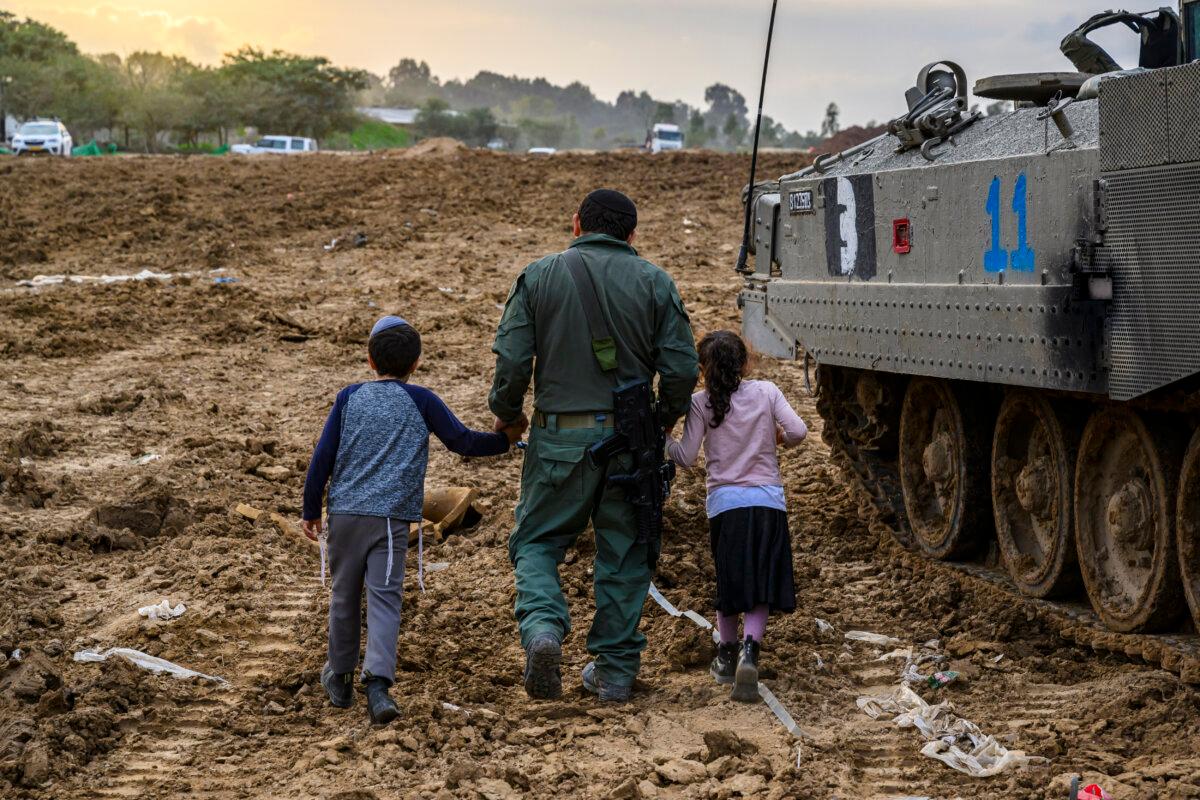 Children visit their father, who is currently on reservist duty, after returning from Gaza, in Southern Israel on Dec. 17, 2023. (Alexi J. Rosenfeld/Getty Images)
Children visit their father, who is currently on reservist duty, after returning from Gaza, in Southern Israel on Dec. 17, 2023. (Alexi J. Rosenfeld/Getty Images)The Litani river flows east to west, roughly 10 miles north of the Israeli border, but only about three miles from Israel’s northern tip near Kiryat Shmona.
Some think Israel must go farther, crushing Hezbollah generally the way it has Hamas, and going deeper into Lebanon to do it.
That area, they say, must become at the very least a buffer, a demilitarized zone, to protect Israel’s civilians in the country’s north.
Others speak in starker terms of having to ethnically cleanse it. Hezbollah has, over the past two decades, moved in loyalists from other parts of the country, and fighters can easily disguise themselves as civilians. If they’re allowed to stay, the threat remains.
But no one can say whether or how Israel can make such an action stick internationally without becoming even more of a pariah than it is now.
She Can’t Go Home
Elidar Elhayani has been staying with her parents in Kfar Hananiya for months. It’s perhaps five miles from the Lebanese border and not a frequent rocket target.
She lives in Metula, Israel’s northernmost community, and is one of about 1,700 people surrounded by Lebanon, and thus Hezbollah, on three sides.
It’s at the tip of what Israelis call the Finger of Galilee, a narrow part of Israel thrusting north.
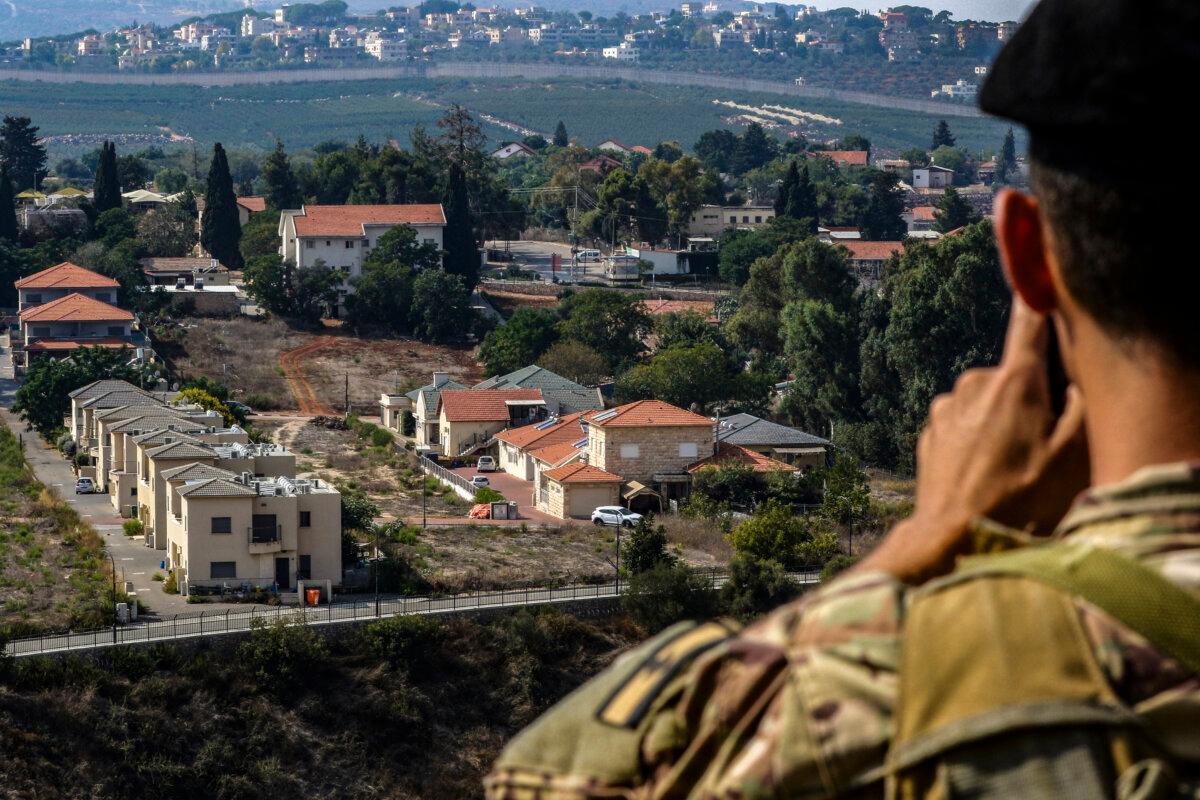 A Lebanese soldier monitors the border area with the northern Israeli town of Metula on Oct. 8, 2023. (MAHMOUD ZAYYAT/AFP via Getty Images)
A Lebanese soldier monitors the border area with the northern Israeli town of Metula on Oct. 8, 2023. (MAHMOUD ZAYYAT/AFP via Getty Images)“I live 50 meters from the border,” she said. She lives with her boyfriend, Aviram Zerach, and their dog.
Oct. 7 was a Saturday morning. As it was the Sabbath, Mr. Zerach had his phone turned off. Ms. Elhayani initially didn’t answer hers when it started ringing and she had the sound turned down. But it kept vibrating as her mother and brother both kept calling her. She finally picked up for her mother.
Ms. Elhayani said, “She screamed: ‘Go! Go away! Don’t stay! Terrorists are attacking Israel! They’re conquering Israel! Just escape!”
 Elidar Elhayani, who had to evacuate her home in Metula, Israel, on Oct. 7, 2023, because it is about 164 feet from the Lebanese border and Hezbollah, is pictured at her parents' home in Kfar Hananya on March 13, 2024. (Dan M. Berger/The Epoch Times)
Elidar Elhayani, who had to evacuate her home in Metula, Israel, on Oct. 7, 2023, because it is about 164 feet from the Lebanese border and Hezbollah, is pictured at her parents' home in Kfar Hananya on March 13, 2024. (Dan M. Berger/The Epoch Times)They initially didn’t know what to do. Where they were was quiet at the moment. There hadn’t been too much trouble, although she acknowledged the Lebanese across the border fence sometimes threw rocks or otherwise tried to provoke them. The Israeli Army and U.N. troops both patrol the border there.
At about 9 a.m. they fled with their dog. They feared a major Hezbollah rocket attack, though it ended up not coming that day.
“We ran away with just a few things,” she said. “We just left because we don’t have a shelter inside of our home. We have one, a bomb shelter, at the end of our street, but it’s like 30 seconds to just run there and it’s way too much.”
Like most Israelis, she knows how much time, to the second, she’s got to take shelter, based on her home’s distance from a hostile border. With her home so close to Hezbollah, they had no choice but to leave.
If she had a safe room in her house, even five seconds would be too long to get inside. “You hear the bomb first, and then the alarm,” she said.
They were nervous driving south, but the roads were quiet. Traffic wasn’t too heavy. Most residents didn’t evacuate until Oct. 16, she said, when Israel ordered it.
Her house has not taken a direct hit since Oct. 7, but a nearby hit broke windows and did some damage.
The whole community, other than its security team, has left, she said.
Jews started the community in the 1860s. The British had a base there until Israel’s independence in 1948. It’s an agricultural community, producing apples, olives, and chickens, and it has a food packing plant.
Ms. Elhayani and Mr. Zerach have been staying in what her parents usually rent out as an Airbnb apartment in Kfar Hananiya.
The war has dampened tourism. In quieter times, tourists staying there might be headed to Tzfat, or Safed, a town famous for its history of medieval Jewish mysticism, or to Tiberias, Nazareth, Capernaum, and other Christian historical sites.
Religious Jews like Kfar Hananiya because it has a big synagogue and regular daily services, according to Dave Bender, who lives there. He is the co-host of a Facebook group with 12,000 members called Life on the Border with Gaza, which deals with, in addition to what its name suggests, Israeli life on the Lebanese frontier.
“I want to go home, but I can’t,” Ms. Elhayani said. “I can’t go home until someone does something.”
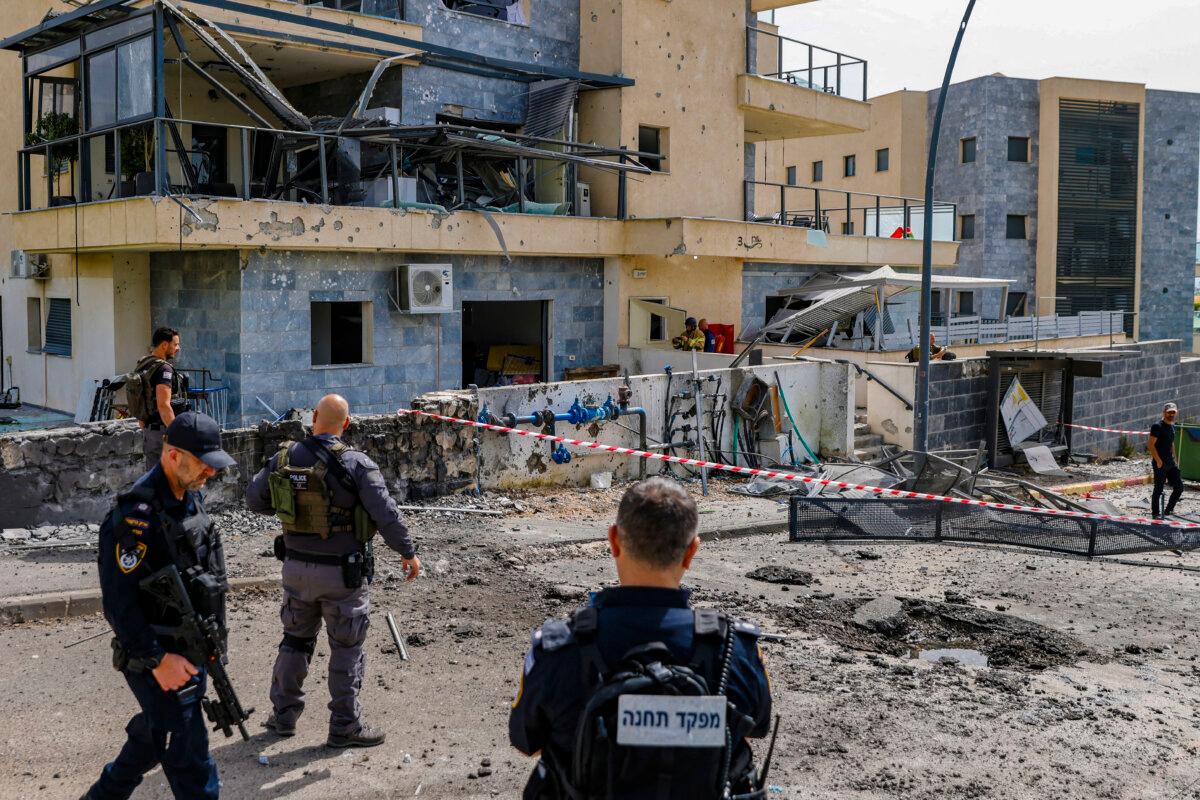 Israeli forces check a building that was hit by a Hezbollah rocket in Kiryat Shmona in northern Israel near the Lebanon border, on March 27, 2024. (JALAA MAREY/AFP via Getty Images)
Israeli forces check a building that was hit by a Hezbollah rocket in Kiryat Shmona in northern Israel near the Lebanon border, on March 27, 2024. (JALAA MAREY/AFP via Getty Images)Why Hezbollah Didn’t Attack on Oct. 7
Israel’s political and military leaders have been excoriated for their policy and intelligence failures leading up to Oct. 7—their gamble that Hamas would not attack, their redeployment of military force away from the south, and their disregarding intelligence suggesting an attack was brewing.
One thing they got right after the attack, though, was their reinforcement of the north, according to retired Maj. Elliot Chodoff.
A reserve major in the IDF, now 68, he wrote many of the army’s tactical manuals still in use, and he later taught political science and terrorism at Haifa University for 25 years. He lives now in Eshchar, about 10 miles from the border.
Hezbollah looked to past fights with Israel, Mr. Chodoff said. Their strategy as Oct. 7 approached and erupted was to wait a few days—to let Israel commit itself to the south and then attack it in the north.
In July and August 2006, Israel fought a war with Hezbollah but didn’t declare war until the following March.
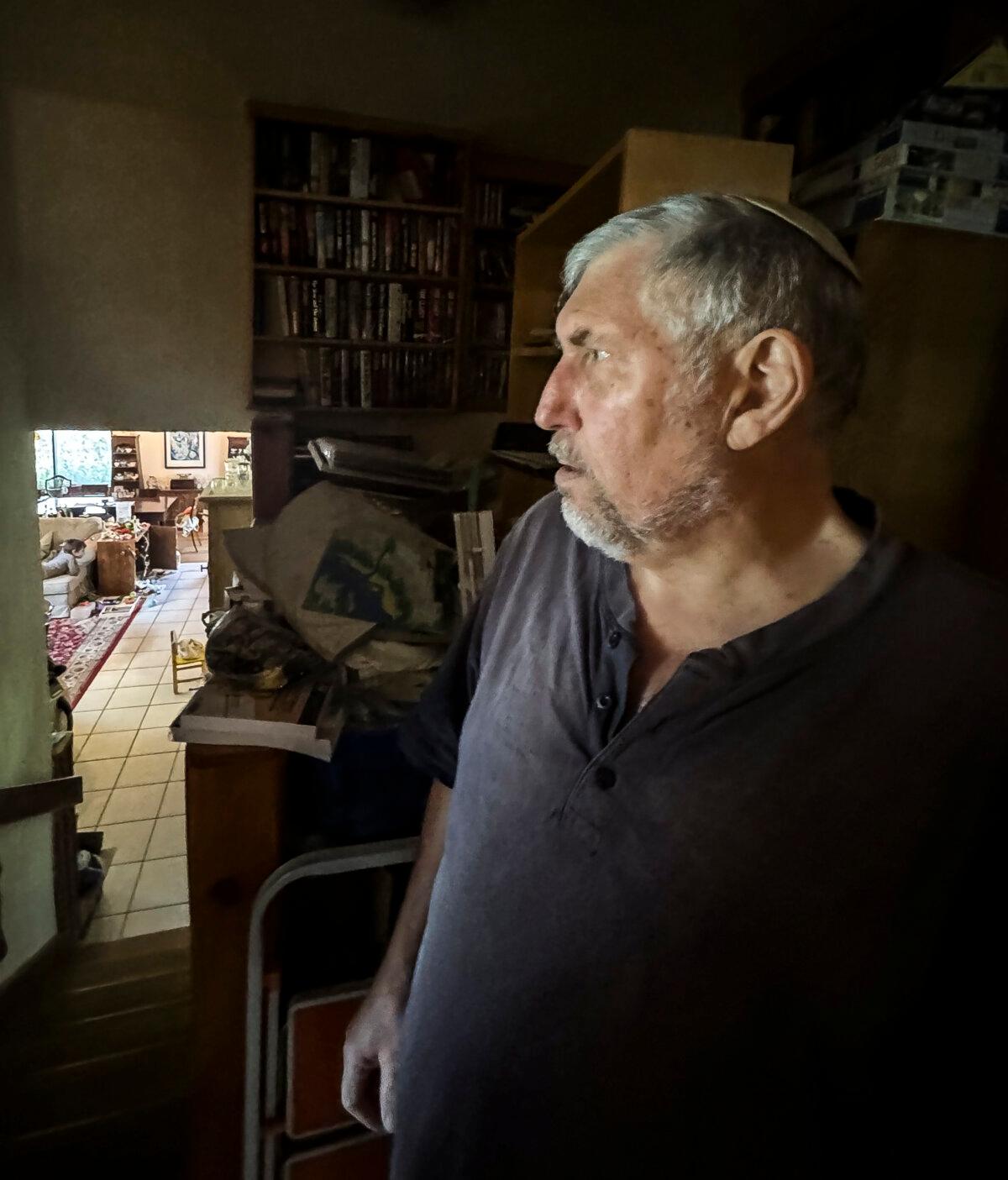 Elliot Chodoff, a retired IDF major and expert in terrorism and military strategy, at his home in northern Israel on March 13, 2024. (Dan M. Berger/The Epoch Times)
Elliot Chodoff, a retired IDF major and expert in terrorism and military strategy, at his home in northern Israel on March 13, 2024. (Dan M. Berger/The Epoch Times)It didn’t happen that way this time, Mr. Chodoff said. By 11 a.m. on Oct. 7, Israel had declared war and begun to mobilize its reserves.
“I was surprised, pleasantly surprised,” he said.
Israel’s government, like that of the United States, generally hesitates to formally declare war because of the legal implications. Fighting happens, but it isn’t called war.
This time, Israel didn’t hesitate.
The country’s divisions had played into Hamas’s decision to attack, he said. Thousands of people had demonstrated for months opposing Prime Minister Benjamin Netanyahu’s plans to reform the Supreme Court.
His coalition sees the court as wildly liberal and acting without restraint as the country has no constitution. They want to bring it back under the Knesset’s control.
Opponents, though, see this as a threat to civil liberties. Unprecedented tensions included reservists’ threatening not to report for reserve duty, and that included some generals.
“[Hezbollah leader Hassan] Nasrallah probably thinks: ‘You know what, let’s give it a few days. Let the army get engaged down there. Let Israel start tearing itself apart, and then I’ll launch my attack up here,'” Mr. Chodoff said.
That didn’t happen either.
“The morning of Oct. 7, the demonstrations leader said: ‘The demonstrations are over. Anybody who said they’re not going to serve, forget about it. You get called, you go. The country’s under attack.’ In other words, the polarization ended, around 11 o'clock in the morning,” he said.
“There was an incredibly effective bounce back.”
Israel faced a brigade-strength attack of between 2,000 and 3,000 Hamas fighters that initially succeeded. Hamas was planning to hold positions for up to a month, Mr. Chodoff said.
He said that within 36 hours, they were all dead, apart from those who escaped to Gaza.
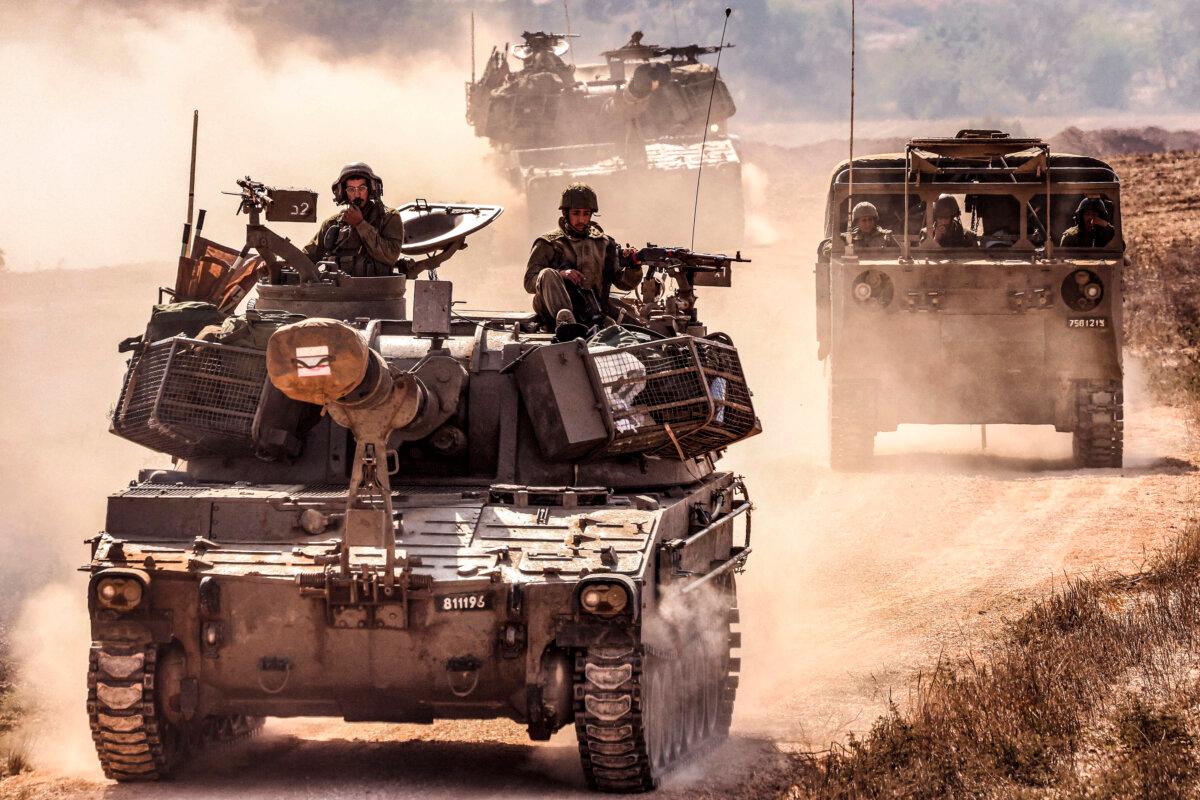 An Israeli army artillery howitzer moves at a position near the border with the Gaza Strip in southern Israel on Nov. 3, 2023. (JACK GUEZ/AFP via Getty Images)
An Israeli army artillery howitzer moves at a position near the border with the Gaza Strip in southern Israel on Nov. 3, 2023. (JACK GUEZ/AFP via Getty Images)Many Israeli reservists didn’t wait for orders to go. They grabbed their weapons and drove toward the Gaza perimeter to fight.
“And Nasrallah looks at that,” he said. “We immediately begin airstrikes and artillery strikes into Gaza. And almost immediately, the largest reserve call-up in Israel’s history takes place, close to 400,000 reservists [by Oct. 10].”
Mr. Chodoff declined to give an exact figure for the size of Israel’s standing army, noting that that is classified information.
“Call it 150,000. But that’s a false number. That includes basic trainees, clerks, telephone operators, not 150,000 people with a rifle.”
The reservists, though, are mostly combat troops.
“Nasrallah turns around and says, ‘You know, maybe it wasn’t such a good idea,’” he said. “And he mentally backs down.”
Mr. Nasrallah had to show solidarity with Hamas, though, hence the rocket attacks, Mr. Chodoff said.
The import of this can’t be overstated. Many analysts think Hamas, disturbed by the possibility of Saudi Arabia’s joining the Abraham Accords to recognize Israel diplomatically and begin cooperating with it economically and on defense, started this war out of desperation.
Its strategic goal was to provoke a widespread uprising against Israel—by Palestinians from the West Bank, Hezbollah from Lebanon, and maybe some Arab governments.
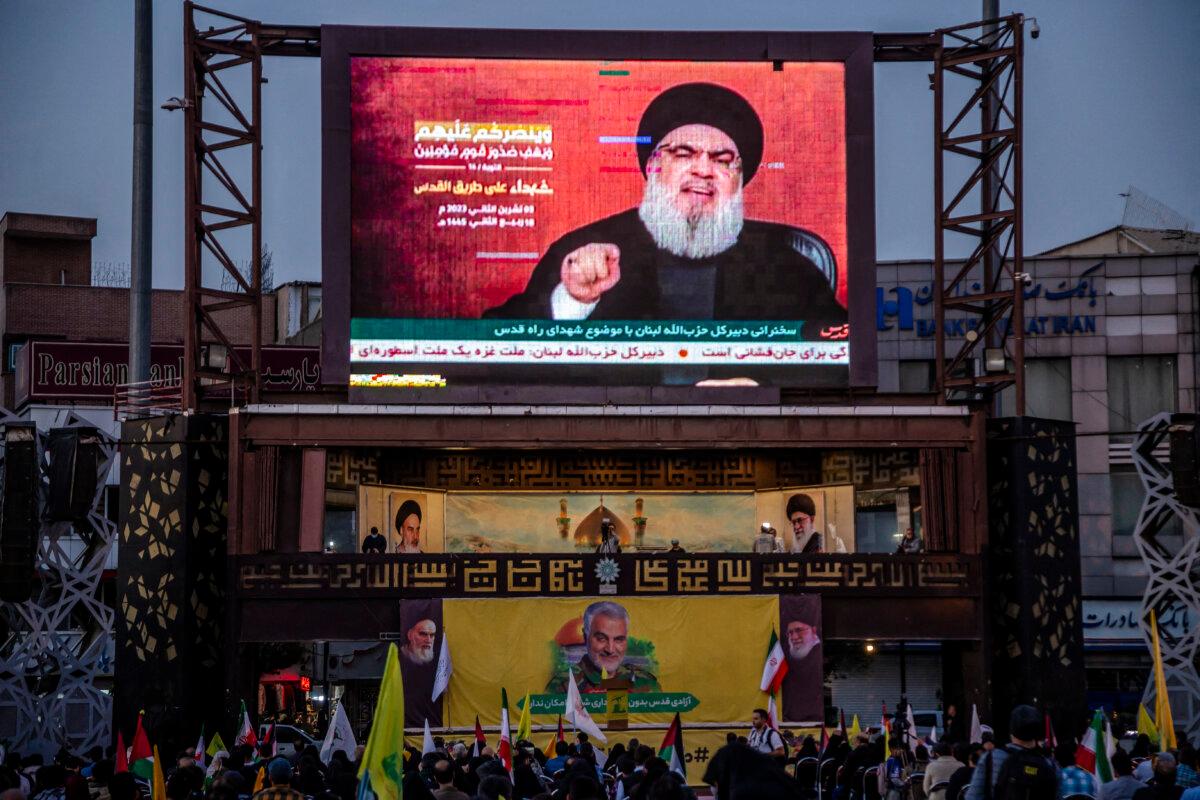 People gather to watch Hezbollah Secretary General Hassan Nasrallah's speech regarding the Israel-Hamas conflict in Tehran, Iran, on Nov. 3, 2023. (HOSSEIN BERIS/Middle East Images/AFP via Getty Images)
People gather to watch Hezbollah Secretary General Hassan Nasrallah's speech regarding the Israel-Hamas conflict in Tehran, Iran, on Nov. 3, 2023. (HOSSEIN BERIS/Middle East Images/AFP via Getty Images)Hezbollah, the most significant of those—a heavily armed, profoundly anti-Israel group backed by Iran—in the end didn’t join. Neither, then, did anyone else. Israel, which could have found itself fighting a multi-front war, didn’t.
Israel’s evacuation of the northern border zone was tactically a good move, he said, removing Mr. Nasrallah’s incentive for an attack on Israel’s north.
Strategically, though, there’s a downside, Mr. Chodoff said: “Now we’ve locked ourselves into a reality that in order to bring these people back, we have to remove the threat from the border.”
He predicted Israel would, when finished with Hamas, attack and clean out, at the very least, the area south of the Litani River.
Hezbollah could change the equation at any time by attacking, he said. Its rocketing of Israel, and Israel’s retaliation, each hitting back harder than it was hit, creates a cycle of escalation. Hezbollah fired a hundred rockets on a recent day in early March and did massive damage in cities such as Kiryat Shmona.
“Take that same hundred rockets, fire them into Haifa, and you’ve got a war on your hands, that day,” he said. The same could happen if a rocket attack had a huge death toll.
Israel may be waiting for the end of the rainy season, which had been heavy in the north. Ground forces get bogged down in mud, with atmospheric conditions poor for air and artillery support.
Israel won’t face the same urban warfare conditions it has in Gaza, he said. South Lebanon is rural, a place of farms and small villages. Many are now inhabited by Hezbollah loyalists, Shiites from poor neighborhoods in Beirut or from Baalbek.
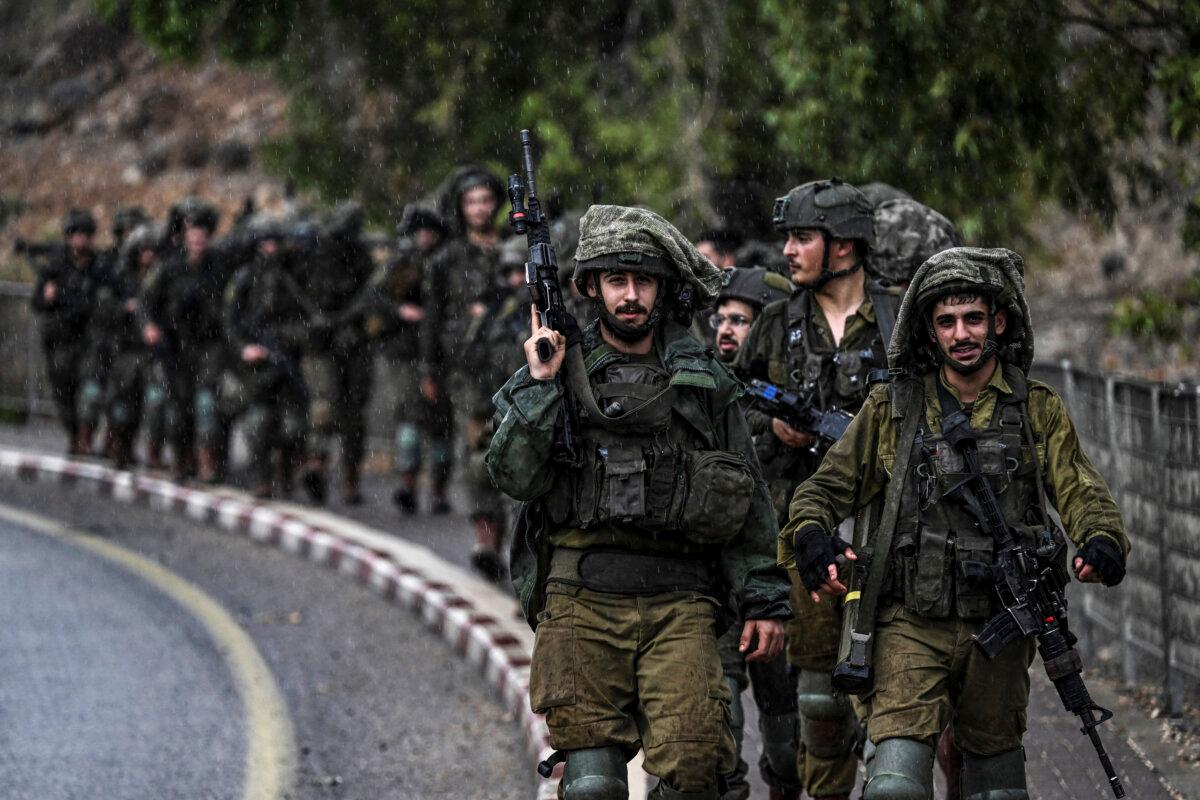 Israeli army soldiers patrol an undisclosed area in northern Israel bordering Lebanon on Oct. 15, 2023. (ARIS MESSINIS/AFP via Getty Images)
Israeli army soldiers patrol an undisclosed area in northern Israel bordering Lebanon on Oct. 15, 2023. (ARIS MESSINIS/AFP via Getty Images)Hezbollah gave them houses vacated when the Christian South Lebanon Army, a militia allied with Israel and helping it maintain south Lebanon as a buffer zone since 1982, collapsed in 2000 following Israel’s withdrawal of its troops.
Israel may not resort to heavy bombing, Mr. Chodoff said. He noted bombing can backfire militarily; the resultant rubble creates great defensive positions for the enemy.
But the army will be able to fight with high speed maneuvering, working in the open spaces between villages to cut them off from each other, he said. Israel didn’t have that option in the densely urban Gaza Strip.
They would not stop at the Litani River, he predicted. U.N. Resolution 1701, which allows only the Lebanese Army and U.N. troops to bear arms between it and the Israeli border, “failed on day two.”
“There’s no need to conquer Lebanon,” he said. “But there is a need again to go after Hezbollah’s centers, its bases, and there will be heavy aerial attack against Dahieh, their neighborhood in Beirut.
“Baalbek, which we’ve already struck a few times now, is where their air defenses are based.”
He added that there could be “possible operations along the Lebanese–Syrian border to cut them off from Iranian support coming through Syria.”
“The idea isn’t to cause wanton destruction to Lebanon,” he said. But anything of military value, such as roads and bridges, is fair game. He said he thinks Israel will go at least as far north as the Beirut-Damascus Highway, about 40 miles north of the border.
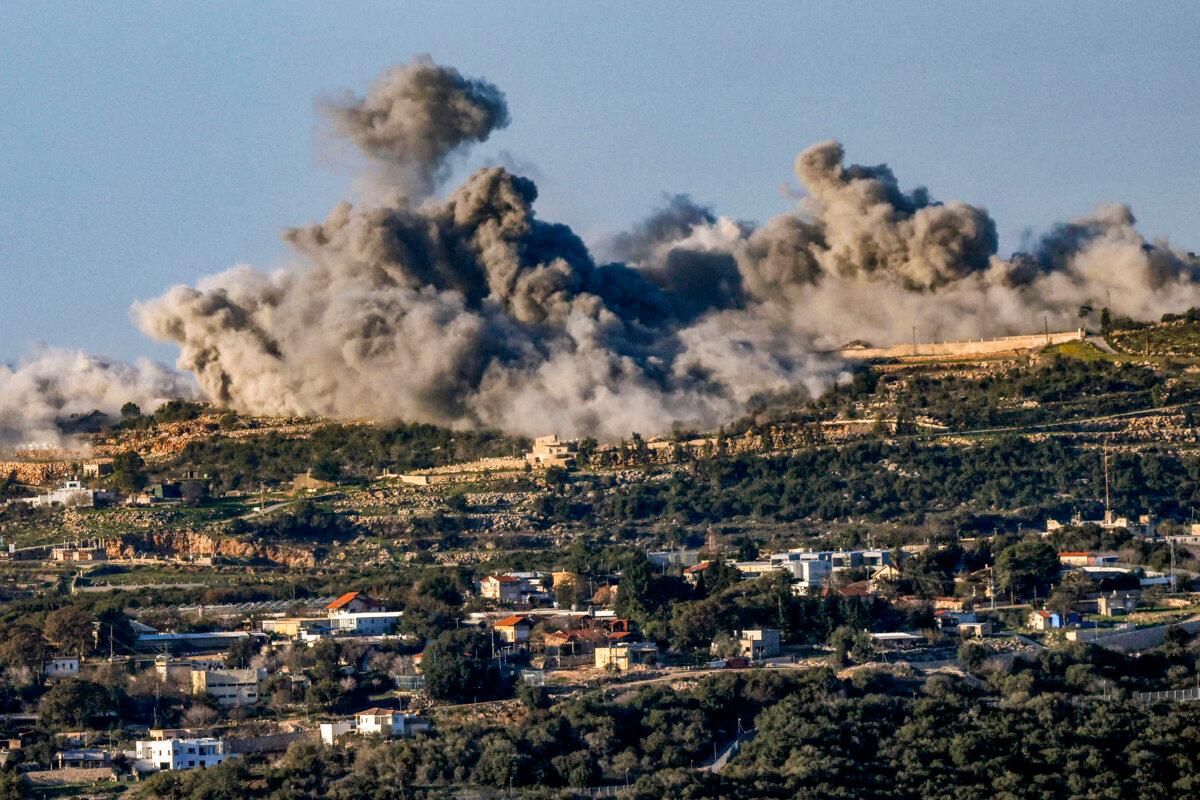 Smoke billows in the southern Lebanese village of Marwahin following Israeli bombardment amid ongoing cross-border tensions on Dec. 26, 2023. (JALAA MAREY/AFP via Getty Images)
Smoke billows in the southern Lebanese village of Marwahin following Israeli bombardment amid ongoing cross-border tensions on Dec. 26, 2023. (JALAA MAREY/AFP via Getty Images)Israel Has No Good Options
Sarit Zehavi retired as a lieutenant colonel in Israeli army intelligence, specializing in the northern front. After her retirement a decade ago, she opened an independent institute, the Alma Center, to do the same thing in the private sector.
Her job’s different now, she told The Epoch Times. She used to focus on briefing the military on things such as the terrain and which villages were where, and she was constrained in what she could say.
Now she faces no such constraints. The Alma Center briefs delegations to the border. She tries to give them the full picture of what it’s like to live in northern Israel, as she and her staff of a dozen people all do. Her office in the Tefen Industrial Zone is about seven miles from the border.
They’re up close and personal with Hezbollah. She showed a reporter a photo of a Hezbollah fighter. The reporter said, “Shot with a long lens, right?”
No, she said—shot with her cellphone from about 50 meters away.
Hezbollah, she said, has ramped up its activity close to Israel’s border the past two years, and more so in the year leading up to Oct. 7, she said. There were verbal exchanges with Israeli troops. Hezbollah fighters would cross the border or touch the fence, and then withdraw, testing Israel’s responses.
This, she said, was not just to try to provoke an incident, or to dull Israeli reactions, but to prepare for an invasion.
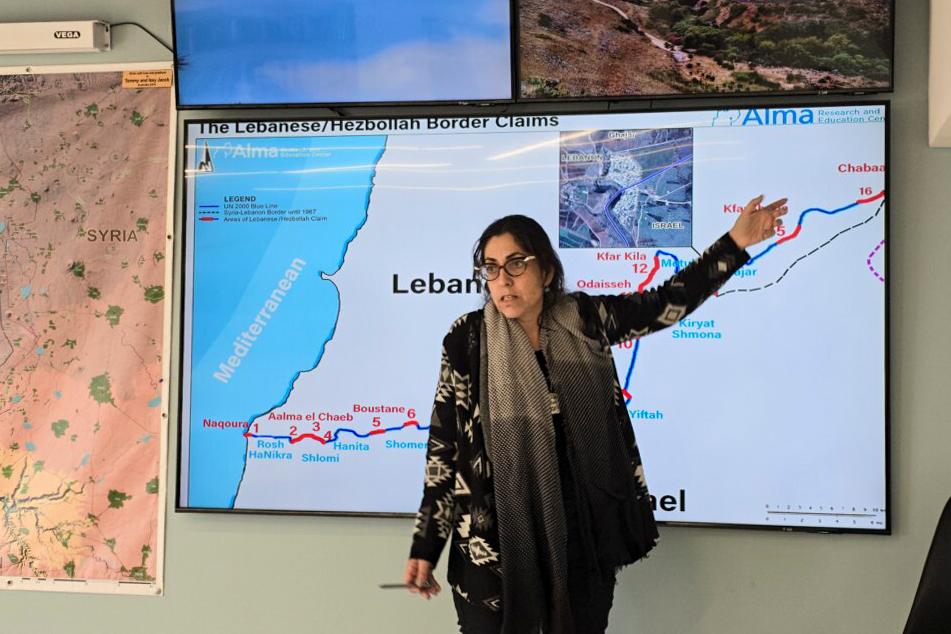 Sarit Zehavi of the Alma Center in Israel's Tefen Industrial Zone lectures visitors about the Israel–Hezbollah border faceoff on March 13, 2024. (Dan M. Berger/The Epoch Times)
Sarit Zehavi of the Alma Center in Israel's Tefen Industrial Zone lectures visitors about the Israel–Hezbollah border faceoff on March 13, 2024. (Dan M. Berger/The Epoch Times)There have been other ominous warnings. Iran supports about 16 militia and terror organizations in different nations in addition to the Gaza Strip and the West Bank, which it sees as a unified front against Israel, she said.
It’s not unified in the sense of being a single army or having a single chain of command, and the different groups have different local priorities, she said. But they all get money, munitions, training, and support from Iran’s Islamic Revolutionary Guard Corps.
And she said she doesn’t see Israel as necessarily having deterred Hezbollah. She said she doesn’t think Hezbollah necessarily planned to attack at the same time as Hamas. She said Hezbollah is biding its time, fighting on the international and economic fronts and sowing division in Israel’s domestic politics, as well as fighting it militarily.
Hezbollah alone has more than 200,000 missiles and rockets. Most are short-range mortars, but some have long enough ranges to hit most places in Israel.
What has recently preoccupied Israelis in the north is Hezbollah’s recent use of anti-tank missiles. These have flat flight paths and hit targets in seconds, giving no chance to get to shelter. Countermeasures are ineffective because they electronically get lost in ground clutter. These aren’t rocket-propelled grenades. They can go three miles—the most advanced ones can go about six.
“They are not launched against tanks,” Ms. Zehavi said. “It’s important for me to emphasize that. They are also launched against homes.”
A foreign worker had been killed the previous week by such a missile, fired at a school auditorium.
Use of these weapons against civilian targets is a war crime, Mr. Chodoff said.
Hezbollah has escalated its rocket attacks, Ms. Zehavi said. For the first few months after Oct. 7, it was mostly shorter-range missiles firing within the evacuated zone. Then they started using longer-range ones.
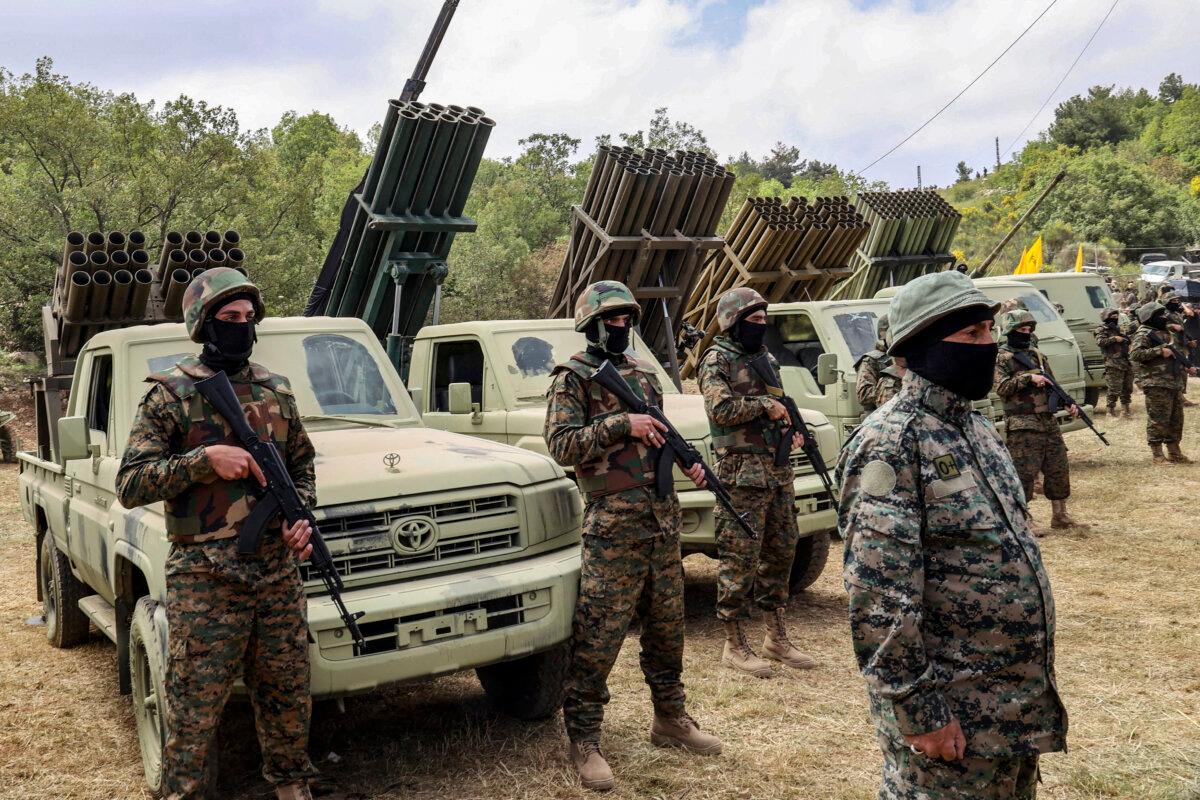 Lebanese Hezbollah fighters stand near multiple rocket launchers during a press tour in the southern Lebanese village of Aaramta, on May 21, 2023. (ANWAR AMRO/AFP via Getty Images)
Lebanese Hezbollah fighters stand near multiple rocket launchers during a press tour in the southern Lebanese village of Aaramta, on May 21, 2023. (ANWAR AMRO/AFP via Getty Images)She mentioned her own experience a few days prior. In their community, which she asked The Epoch Times not to name, she was driving her daughter after school to a fencing lesson when the air raid sirens went off.
They pulled over and got out of the car to lie down flat on the ground. They’re supposed to cover their heads, but she knew she should cover her daughter’s head with her own body. She didn’t have enough time to do that. An interceptor demolished the incoming rocket overhead, causing a shower of debris nearby. Her own failure to protect her daughter has haunted her, she said.
The rocketing of the evacuated communities means people can’t go home, and although the longer-range rockets can be intercepted, her own experience shows the problems. “You cannot live like that,” she said.
The IDF has targeted Hezbollah’s commando unit to forestall an invasion, but it’s not clear how successful the IDF was.
And the rockets and missiles are a threat, and Israel knows Hezbollah has vast quantities in reserve—far more than they’ve fired so far. Other unknowns include how fast Hezbollah will recover if there is a cease-fire.
“It’s not a full-scale war in the north. It’s a war of attrition,” Ms. Zehavi said. She said she fears that if it erupts into a full-scale war, Hezbollah will use its more advanced long-range missiles.
“Imagine a missile that is accurate and that can get to the Knesset, can get to a mall in Tel Aviv, or a hospital in Haifa, or the seaport,” she said. “That’s the capability of these missiles.”
Israel’s options include attacking, starting full-scale war against Hezbollah, but it’s not a good option because of their rockets, she said.
A second option is one currently being advanced by the U.S. government, a cease-fire, which is also a bad option as that leaves Hezbollah free to resume what it’s been doing.
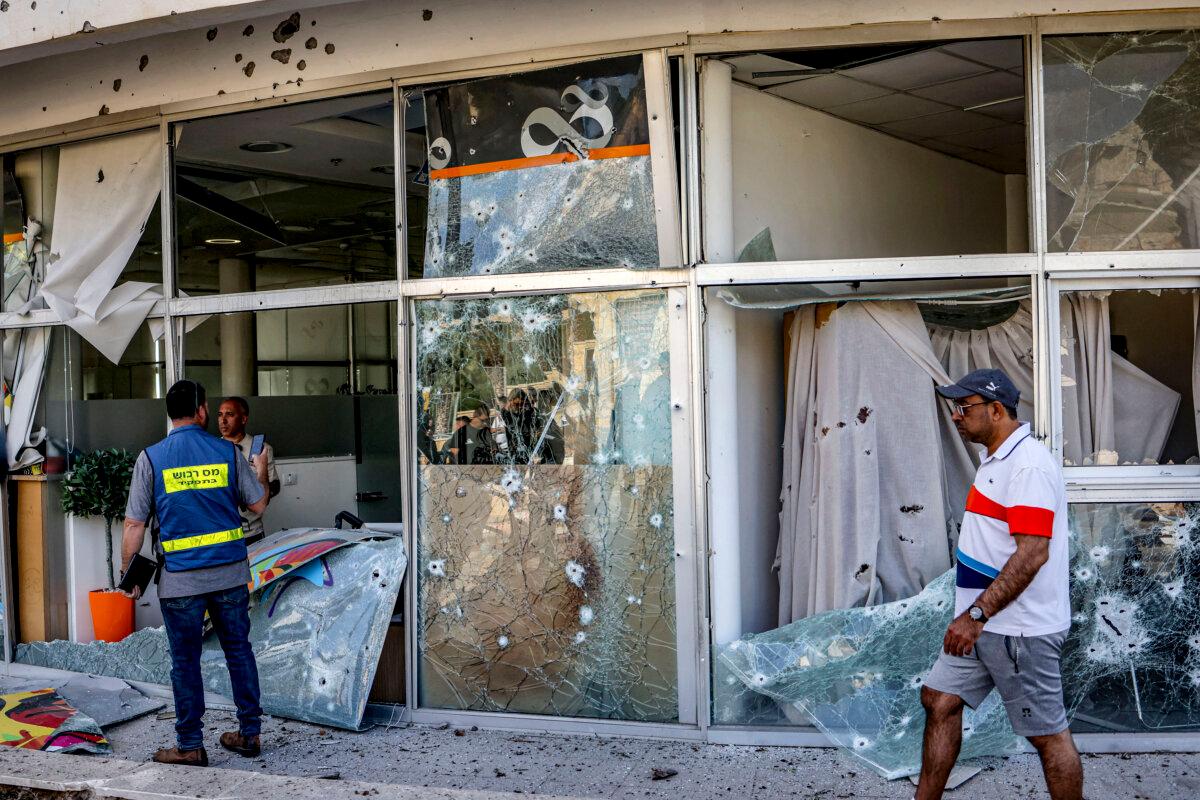 People view the damaged glass facade of a building in the aftermath of intercepted rocket fire launched from Lebanon on Israel in its northern town of Shlomi April 6, 2023. (OREN ZIV/AFP via Getty Images)
People view the damaged glass facade of a building in the aftermath of intercepted rocket fire launched from Lebanon on Israel in its northern town of Shlomi April 6, 2023. (OREN ZIV/AFP via Getty Images)The third option is what the IDF is already trying to do: damage Hezbollah’s capabilities while keeping the conflict below the intensity of a full-scale war. The IDF recently published that it had attacked 5,000 Hezbollah targets, including 450 of its commando units.
“That means a lot of damage to Hezbollah, but again, the question is, even though there is a lot damage, how much time it will take for them to recover if we stop now?”
Hezbollah uses Hamas’s human-shield tactics—which are also war crimes—hiding headquarters, launchers, missiles, and military infrastructure inside homes and towns in south Lebanon, she said. They currently launch anti-tank missiles from inside homes or mosques.
Hezbollah’s tactics include beginning with rocket and artillery attacks, increasing to commando raids across the border, trying to take hostages, and then escalating from there, she said, much like what Hamas did on Oct. 7. The idea is if they provoke Israel into starting a full-scale war, they reap a propaganda benefit when Israel is inevitably portrayed as the bad guy by the international press.
Ms. Zehavi said she doubts Israel will start an all-out war around June against Hezbollah.
“I don’t think the Israeli government is willing to do it,” she said.
For now it seems committed to its current strategy of using the cycles of attack and retaliation to weaken Hezbollah, and specifically its elite commando units, as much as possible. But a hot war could break out at any time.
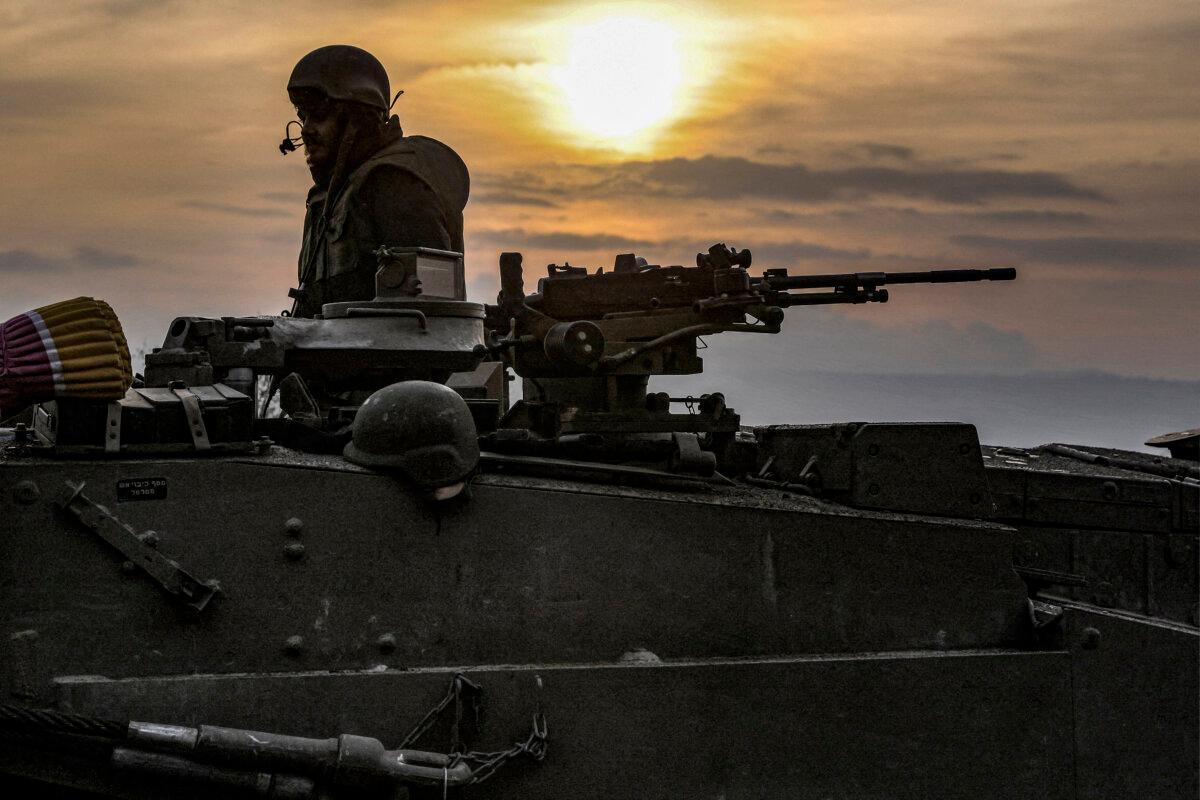 An Israeli army soldier sits in the hatch of the turret of a Merkava battle tank as a column of tanks is amassed in the upper Galilee in northern Israel near the border with Lebanon on Oct. 11, 2023. (JALAA MAREY/AFP via Getty Images)
An Israeli army soldier sits in the hatch of the turret of a Merkava battle tank as a column of tanks is amassed in the upper Galilee in northern Israel near the border with Lebanon on Oct. 11, 2023. (JALAA MAREY/AFP via Getty Images)She said that she and her associates at Alma don’t think the Israelis will ethnically cleanse south Lebanon to solve the problem once and for all. The international pressure against it, including from the United States, would be too strong. And Israel shouldn’t go to war without an international coalition, she said.
She said she’s pessimistic about the chances for a permanent solution. She showed videos of funerals for fallen fighters and one of an old woman screaming on camera in favor of martyrdom for her children and their friends.
The militias in Iran’s united front have turned the defeat of Israel into a holy war, she said.
A cease-fire won’t work, she said, and one that would work, one that had deadlines and was enforced, Hezbollah would never agree to.
“I don’t see a solution,” she said.
Israel needs to acknowledge a changed reality in south Lebanon and change the language of discussing what it wants there, Ms. Zehavi said. Most Hezbollah fighters killed since Oct. 7 lived there.
“It’s not a foreign army that took over south Lebanon. It’s a local militia that’s entrenched inside the towns,” she said.
“I want to see the missiles loaded in trucks and driving north. It’s not going to happen. But it is what I want to see. This what will satisfy me, to feel safe.”
 Sarit Zehavi, a retired Israeli intelligence officer, and expert on its northern front with Lebanon and Syria. (Dan M. Berger/The Epoch Times)
Sarit Zehavi, a retired Israeli intelligence officer, and expert on its northern front with Lebanon and Syria. (Dan M. Berger/The Epoch Times)A trip to Kfar Vradim, about five miles from Lebanon, which is in sight, shows some of the challenges. Looking north from a park in an upscale neighborhood, one can see that both sides of the border are hilly, with communities of both nations visible.
In some areas, Hezbollah has the high ground looking down on Israel. In others, the tables are turned.
Today’s weapons, though, change the equation. Hezbollah’s anti-tank missiles can target anything in Israel they can see, Dave Bender said.
The communities show Israel’s diversity, Ms. Zehavi said: Kfar Vradim is 90 percent Jewish, but one of those visible to the north, Mi‘ilia, is 100 percent Christian. Another, Tarshiha, is one-third Christian and two-thirds Muslim, and it is in a joint municipality with Ma’alot, a Jewish town. Another town a couple of miles to the east, Pki'in, is Druze.
“And we live together,” she said. “This small neighborhood gives me hope that everything is possible. We do have disputes. We have neighbors’ issues. But we live together and I love living [in the north].”
Hezbollah fires at all of them, she said. A Bedouin town on the border, Arav Al-Aramsha, has air-raid sirens going off every day, she said.
While Ms. Zehavi and her visitors were looking at the border, they heard a boom. Roni Gilo, a retired IDF officer, identified it as a 155-mm howitzer.
The first ridge visible is in Israel, she said. On the second ridge beyond it, the lower slope is Israeli and the top is Lebanese. A white line there is the wall dividing the two, along the U.N.’s 2000 Blue Line border, and a white building along that line is a U.N. installation. Hezbollah did an exercise right next to it with guns, uniforms, and flags, she said.
A Lebanese town at the top, Marwahin, and an Israeli one below, Zar‘it, are right next to each other. She used to regularly take visitors to Zar’it, but no longer, she said. It’s been evacuated, and Hezbollah attacks it regularly.
Northerners initially felt lucky on Oct. 7, she said. They knew that what happened to the Gaza border communities could have happened to them.
The 91st Division covering the northern front was underpowered and underprepared, just as the Gaza Division protecting the south was.
“I slept with my shoes on [after Oct. 7],” Ms. Zehavi said. “The IDF was not ready.”
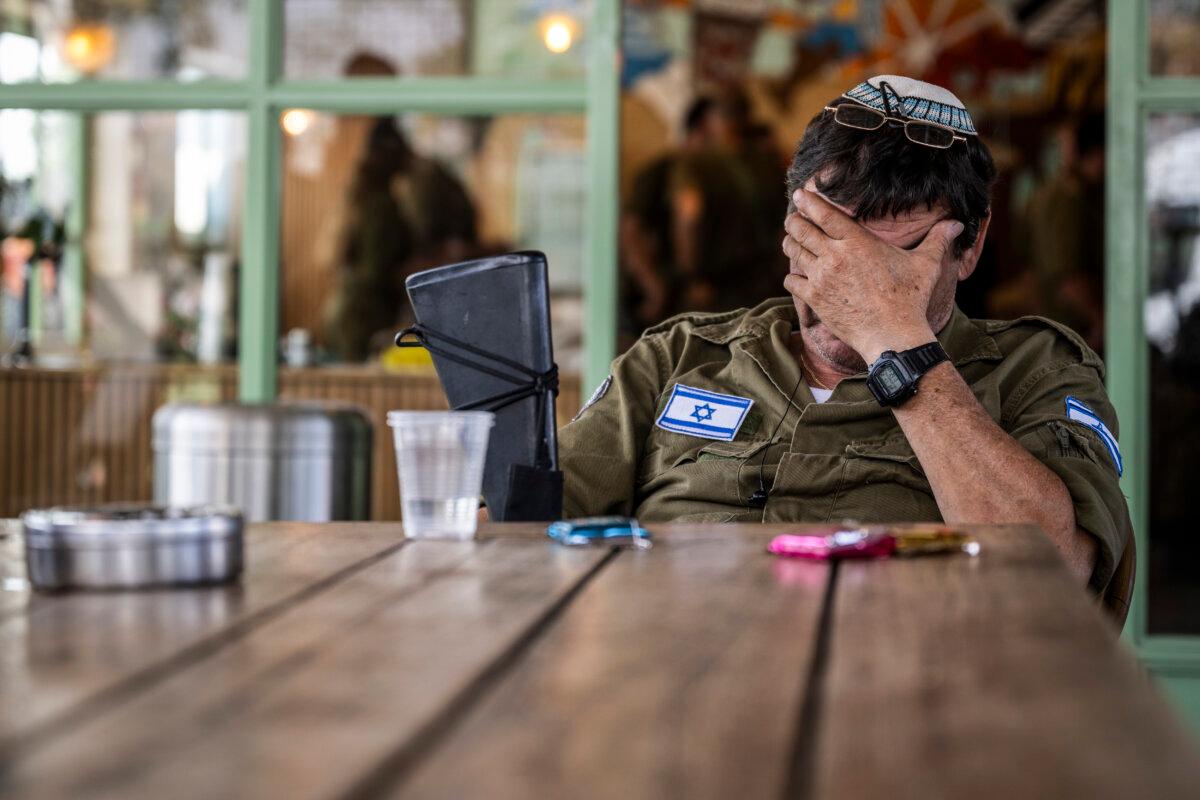 An IDF reservist rests his head in his hand at a cafe near the Gaza border in Urim, Israel, on Nov. 2, 2023. (Alexi J. Rosenfeld/Getty Images)
An IDF reservist rests his head in his hand at a cafe near the Gaza border in Urim, Israel, on Nov. 2, 2023. (Alexi J. Rosenfeld/Getty Images)Israel Has PTSD
Meanwhile, communities all have their rapid-response security teams, who get their weapons from the armory—they aren’t allowed to keep them at home—and go fight. Now most of the members, reservists, have been called up for duty.
Dave Bender is on Kfar Hananiya’s security team. He’s been a journalist in the United States and Israel. Now he’s a beekeeper.
The fact that he’s responsible for the community’s security weighs on him, he said. He’s never far from his multiple phones and sets of keys. He monitors the news constantly. He has a certain edginess about him, and he told an Epoch Times reporter he doesn’t mind being described that way.
He described life in the North. He and his neighbors—most have stayed in his community; he doesn’t see any boarded-up homes and he knows who he sees in synagogue on Shabbat—are tired, but the situation seems without end.
A big attack—featuring, say, an overwhelming bombardment by Hezbollah missiles, or fighters launching an Oct. 7-style attack—hasn’t happened yet, but they know it could come at any time.
“My concern is that it will and that we won’t be prepared enough,” he said.
He also said he worries they'll be abandoned by their “biggest ally,” the United States.
“This country is in full-blown post-traumatic stress disorder, but it’s not post. We’re still in Oct. 7,” he said. The country is still fighting the war, the trauma is still ongoing, and people haven’t been able to deal with what’s happened to them.
His own stress is compounded by having to do something he takes very seriously: using his cellphone on the Sabbath and holidays, when observant Jews don’t.
But he knows he’s responsible for the lives of others, he said. As a security team member, he figures Torah commandments to preserve life outweigh the ban on using phones, and so he does.
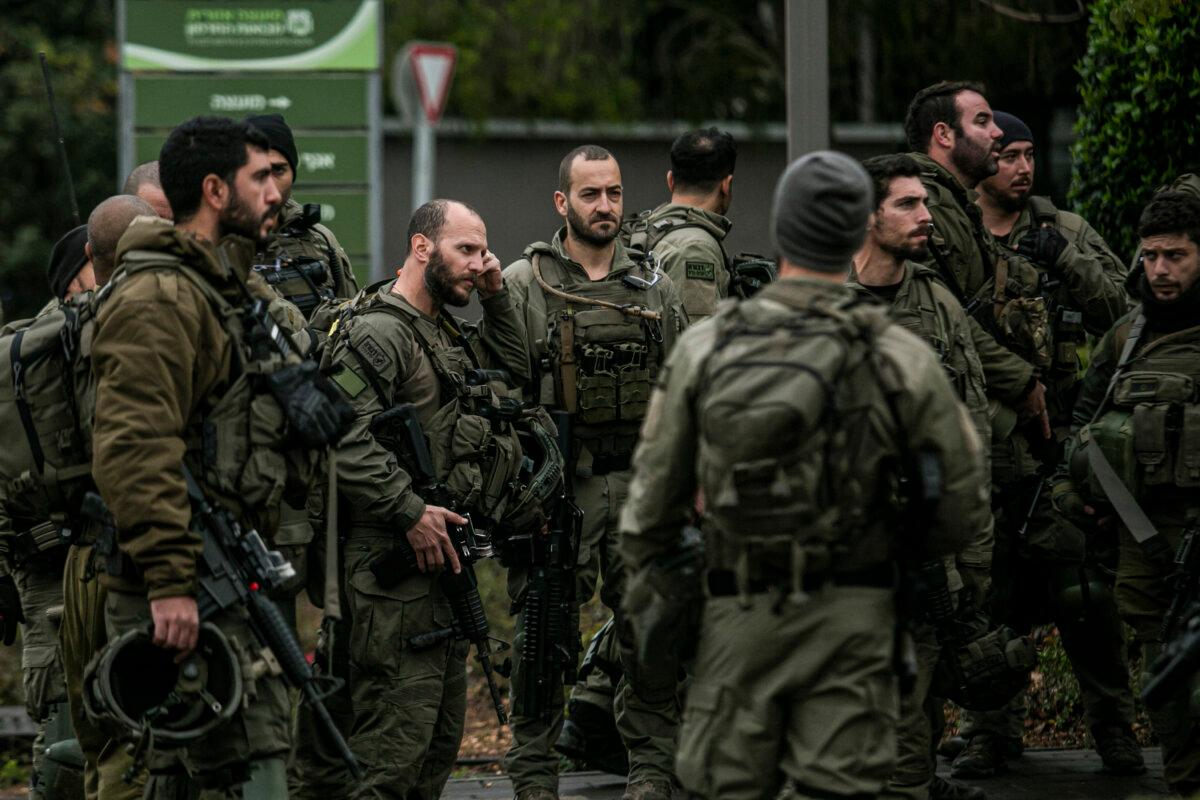 Israeli soldiers prepare to secure in a village near the border with Lebanon, in Mevo'ot HaHermon, Israel, on Jan. 15, 2024. (Amir Levy/Getty Images)
Israeli soldiers prepare to secure in a village near the border with Lebanon, in Mevo'ot HaHermon, Israel, on Jan. 15, 2024. (Amir Levy/Getty Images)He watched his neighbor, a truck driver, run home from synagogue, emerge with a small bag and a pack of cigarettes, get into his truck, and take off. The man pulls a flatbed trailer that hauls tanks, Mr. Bender said, and had to get to a meeting point.
“There’s an idea in the world of six degrees of separation,” he said. “In Israel, it’s two on a bad day. One on a good day. Everyone is one step removed from everyone else and everyone is involved. Everyone, full stop, everyone is involved in what’s going on here. It isn’t like people are living the high life while people on the borders are suffering.”
His daughter, he said, knew 10 people who died at the Nova music festival or kibbutzes attacked on Oct. 7. Ms. Elhayani said she knew three, plus several soldiers who have died fighting.
Northern communities are in limbo, he said. Community leaders have told the government they won’t ask their residents to come home until their safety can be guaranteed.
Ms. Elhayani said people like her can get permission to visit their homes, but they have to go at night, with an Army escort, and stay for no more than 15 minutes.
“It’s like a horror movie,” she said. “Coming quietly, at night. Get whatever you want, and get out.”
She said that she and other northerners feel like the nation is ignoring their plight and doesn’t talk about it.
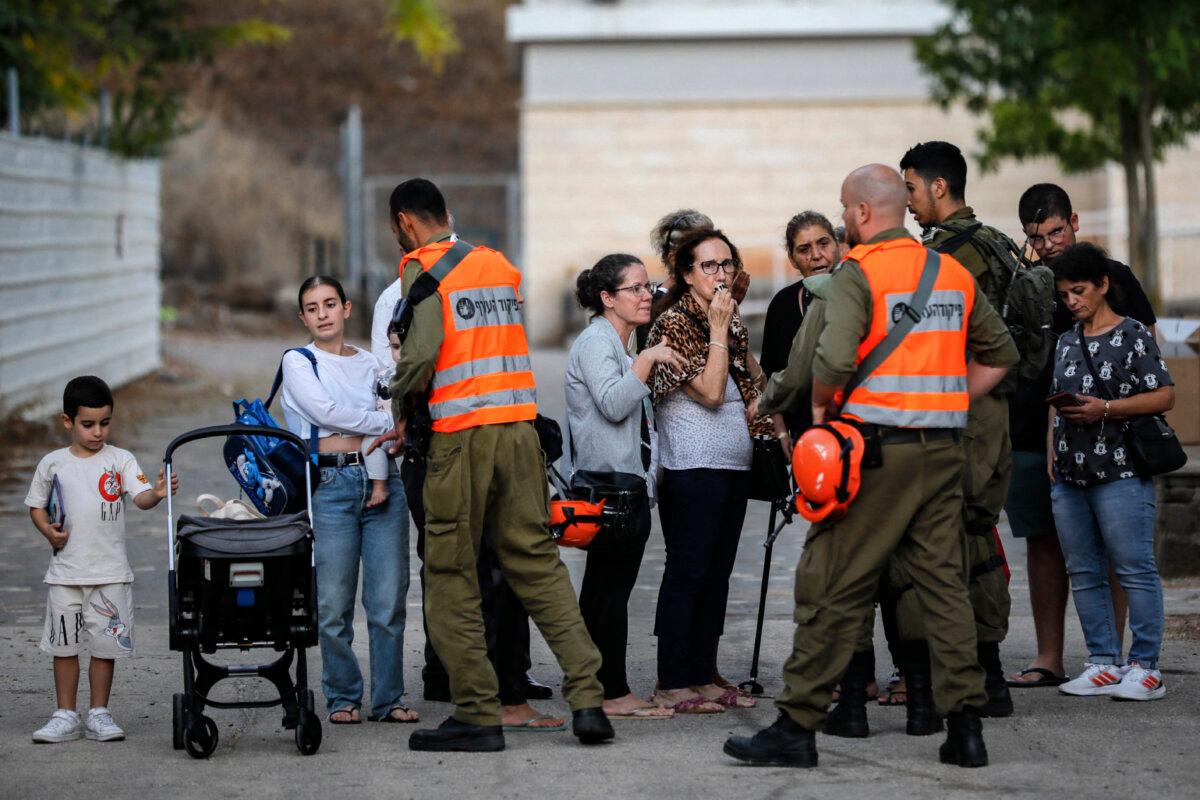 Israeli army soldiers help evacuate residents from the northern city of Kiryat Shmona near the Lebanon border on Oct. 20, 2023. (JALAA MAREY/AFP via Getty Images)
Israeli army soldiers help evacuate residents from the northern city of Kiryat Shmona near the Lebanon border on Oct. 20, 2023. (JALAA MAREY/AFP via Getty Images)“They always talk about Gaza and the south, and, OK, but we have a war here, too,” she said.
“I don’t think people get the sense of the torn feelings we have. It’s very emotional for me.”
She lost three friends who were murdered at the Nova Festival and more who have died as soldiers fighting since then.
“It’s very hard,” she said. “We want to restart our life. We had to leave everything behind.”
Some of her neighbors have left Metula and aren’t coming back, she said.
She recently got her special education degree. She works in occupational therapy, helping people with special needs get into the job market and accompanying them on their journey to work and live on their own. She’s been able to resume working, driving to where her clients are.
Her boyfriend managed vacation properties. “It’s his baby,” she said. “He worked so hard to build his own business. It took us a while to get where we were. And everything stops. And since then he hasn’t worked at all.”
She said there’s no end in sight.
“I’m not pro-war. I don’t like wars. I’m a peaceful human. And I felt very secure in Metula before everything happened,” she said.
“I was living an illusion.”

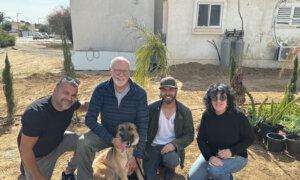












 English (US) ·
English (US) ·  Turkish (TR) ·
Turkish (TR) ·